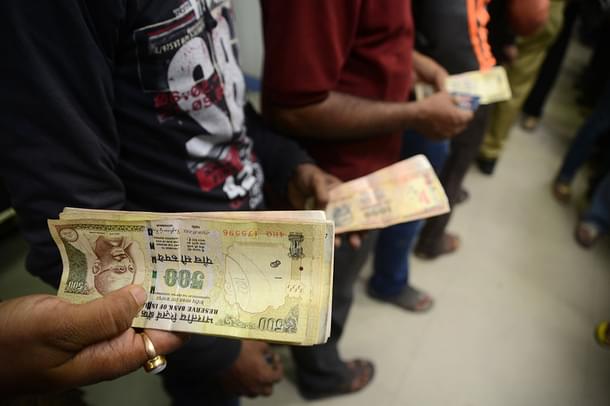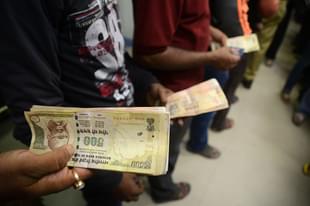Economy
How Much Of The ‘Demonetised’ Currency Is Actually Coming Back?
Arihant Pawariya
May 17, 2018, 05:06 PM | Updated 05:06 PM IST
Save & read from anywhere!
Bookmark stories for easy access on any device or the Swarajya app.


When Prime Minister Narendra Modi announced his decision to scrap the old Rs 500 and Rs 1,000 notes on the night of 8 November, a lot of experts believed that around Rs 2 to 3 lakh crore will not come back into the banking system. The government, they thought, will receive a dividend from the Reserve Bank of India (RBI) after these liabilities were reduced on the central bank's balance-sheet. Though PM Modi or any of his senior cabinet colleagues never made any claims on windfall gains accruing to exchequer due to extinguished RBI liabilities, political pundits suggested that the government's game plan was to deposit a certain amount in Jan Dhan accounts just before the election, project PM Modi as some kind of Robinhood figure, thus sweeping the 2019 election.
However, that may not be the case any longer. The government is probably not expecting to reap any one-time substantial gain from the money not coming back. It is rather hoping that this exercise will lead to identification of millions of new potential taxpayers thus bringing a sustainable stream of revenue for the government and not just a one-time dividend. Why the expectation that all the currency in scrapped notes will find its way back into the banks has risen? There are two reasons.
First, so far Rs 11.55 lakh crore has already come back, as informed by RBI’s deputy governor R Gandhi during the customary press conference held after the bi-monthly Monetary Policy Committee meeting yesterday (8 December).
Based on RBI’s balance sheet for the financial year ending 31 March 2016, the value of specified bank notes withdrawn was initially estimated to be around Rs 14.63 lakh crore. On Tuesday (29 November), in a reply to a question in the Rajya Sabha, Minister of State for Finance Arjun Ram Meghwal said that there were 17,165 million pieces of Rs 500 notes and 6,858 million pieces of Rs 1,000 notes in circulation on the day Modi made his historic announcement. The total amount of high denomination currency circulating in the system on 8 November was, thus, Rs 15.44 lakh crore (Rs 8.58 lakh crore in Rs 500 notes and Rs 6.86 lakh crore in Rs 1,000). This means that close to Rs 4 lakh crore is yet to come back.
Second, the government has given a way out to those with unaccounted money. An important difference between the time the Prime Minister announced a stop date, to now is the introduction of another Income Disclosure Scheme (IDS), which was not originally planned. With the introduction of this new IDS, one would rationally accept that majority of the black money would come back through IDS. This being the case, the quantum of unclaimed liability for any possible transfer back to government as dividend will not be significant enough. What the government would have otherwise received as a windfall gain, is now coming to them in the form of taxes and interest-free deposit for four years.
As NITI Aayog Vice Chairman Arvind Panagariya also says in his Business Standard interview today (8 November) that “the expectation of black money not being returned to banks was valid prior to the latest amendment to the Income Tax Act. But the amendment allows an individual to disclose black money with a 50 per cent tax and a 25 per cent contribution to the Prime Minister’s fund for the welfare of the poor (Pradhan Mantri Garib Kalyan Yojana)... Therefore, you should now expect all Rs 500 and Rs 1,000 notes to come back into the system.”
However, many still don’t agree with the assumption that all of the remaining Rs 4 lakh crore will come back. The State Bank of India (SBI) in its Ecowrap report released on 2 December had argued that Rs 2.5 lakh crore will not find its way back into banks. This figure may be an overestimate, but SBI chief economist Soumya Kanti Ghosh continues to be bullish on the bank’s prediction. “I still think Rs 2.5 lakh crore will not come back to the system,” The Economic Times quoted Ghosh as saying.
Even the total deposit figure (Rs 11.55 lakh crore) put out during the RBI press conference carries the possibility of double counting. Ghosh told the Economic Times that “in the Rs 11.5 lakh crore number there is a lot of double counting. We think that the total deposits garnered so far are lower than that number.”
A senior banking consultant also told Swarajya that there was a possibility of double counting. “RRBs, DCBs, foreign banks etc are parking their cash with various chests of banks across the country. They technically are becoming the host banks’ deposits. Hence, when RBI asks all banks for a count, some chests could be double counting. This could have a small to medium impact depending on how pervasive this is,” he said.
If the double counting is indeed pervasive, then the RBI’s figure of Rs 11.55 lakh crore could be way off the mark and all the calculations go out of the window. The bottomline is this: no one really knows how much is coming back (or not). Everyone is playing the guessing game. Let’s wait for the 31 December deadline. Only after that, the real picture can emerge.
Arihant Pawariya is Senior Editor, Swarajya.





